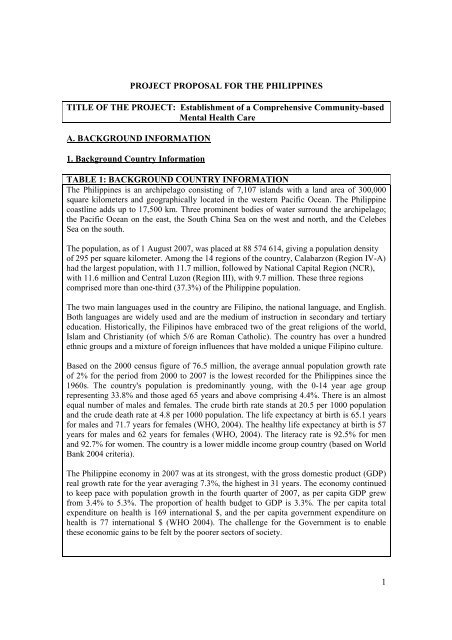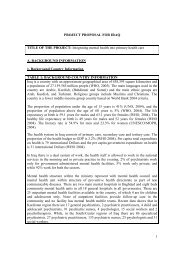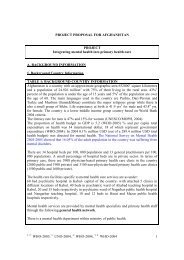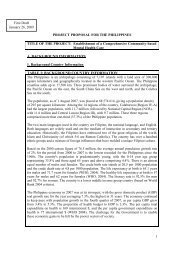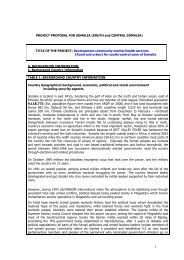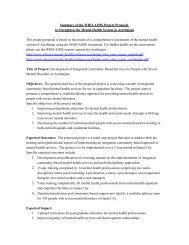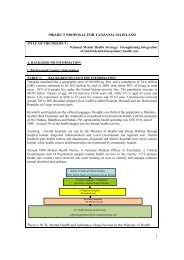Project Proposal - THE PHILIPPINES - Cittadinanza
Project Proposal - THE PHILIPPINES - Cittadinanza
Project Proposal - THE PHILIPPINES - Cittadinanza
You also want an ePaper? Increase the reach of your titles
YUMPU automatically turns print PDFs into web optimized ePapers that Google loves.
PROJECT PROPOSAL FOR <strong>THE</strong> <strong>PHILIPPINES</strong><br />
TITLE OF <strong>THE</strong> PROJECT: Establishment of a Comprehensive Community-based<br />
Mental Health Care<br />
A. BACKGROUND INFORMATION<br />
1. Background Country Information<br />
TABLE 1: BACKGROUND COUNTRY INFORMATION<br />
The Philippines is an archipelago consisting of 7,107 islands with a land area of 300,000<br />
square kilometers and geographically located in the western Pacific Ocean. The Philippine<br />
coastline adds up to 17,500 km. Three prominent bodies of water surround the archipelago;<br />
the Pacific Ocean on the east, the South China Sea on the west and north, and the Celebes<br />
Sea on the south.<br />
The population, as of 1 August 2007, was placed at 88 574 614, giving a population density<br />
of 295 per square kilometer. Among the 14 regions of the country, Calabarzon (Region IV-A)<br />
had the largest population, with 11.7 million, followed by National Capital Region (NCR),<br />
with 11.6 million and Central Luzon (Region III), with 9.7 million. These three regions<br />
comprised more than one-third (37.3%) of the Philippine population.<br />
The two main languages used in the country are Filipino, the national language, and English.<br />
Both languages are widely used and are the medium of instruction in secondary and tertiary<br />
education. Historically, the Filipinos have embraced two of the great religions of the world,<br />
Islam and Christianity (of which 5/6 are Roman Catholic). The country has over a hundred<br />
ethnic groups and a mixture of foreign influences that have molded a unique Filipino culture.<br />
Based on the 2000 census figure of 76.5 million, the average annual population growth rate<br />
of 2% for the period from 2000 to 2007 is the lowest recorded for the Philippines since the<br />
1960s. The country's population is predominantly young, with the 0-14 year age group<br />
representing 33.8% and those aged 65 years and above comprising 4.4%. There is an almost<br />
equal number of males and females. The crude birth rate stands at 20.5 per 1000 population<br />
and the crude death rate at 4.8 per 1000 population. The life expectancy at birth is 65.1 years<br />
for males and 71.7 years for females (WHO, 2004). The healthy life expectancy at birth is 57<br />
years for males and 62 years for females (WHO, 2004). The literacy rate is 92.5% for men<br />
and 92.7% for women. The country is a lower middle income group country (based on World<br />
Bank 2004 criteria).<br />
The Philippine economy in 2007 was at its strongest, with the gross domestic product (GDP)<br />
real growth rate for the year averaging 7.3%, the highest in 31 years. The economy continued<br />
to keep pace with population growth in the fourth quarter of 2007, as per capita GDP grew<br />
from 3.4% to 5.3%. The proportion of health budget to GDP is 3.3%. The per capita total<br />
expenditure on health is 169 international $, and the per capita government expenditure on<br />
health is 77 international $ (WHO 2004). The challenge for the Government is to enable<br />
these economic gains to be felt by the poorer sectors of society.<br />
1
The goal of the Department of Health is align with the WHO health system framework: better<br />
health outcome for the entire population, responsive health care system and equitable health<br />
care financing. The strategic thrusts to achieve the primary goals are anchored on the current<br />
program of health reforms focused on four general objectives: (1) health financing to ensure<br />
better and sustained investment for health to provide equity for the poor; (2) health regulation<br />
to assure access to quality and affordable health products and services; (3) health service<br />
delivery to improve access to essential health interventions; and (4) good governance to<br />
improve health system performance at national and local levels.<br />
With the devolution of health services to LGUs under the local government Code of 1991,<br />
fragmentation of services became evident. Service provision is regarded as ‘dual’, consisting<br />
of both the public and private sector. The public sector has largely independent segments or<br />
sets providers: (1) national government providers, which include, among others, hospitals run<br />
by national government agencies (e.g., hospitals of the Department of Health and the<br />
Department of National Defense), central and regional offices of the Department of Health;<br />
(2) provincial government providers, which include provincial hospitals, provincial blood<br />
banks and the Provincial Health Office; and (3) local (municipal or city) government<br />
providers, including rural health units or RHUs, city health centres and barangay health<br />
stations or BHSs. Each BHSs is staffed by midwife, and each RHU by doctor, a nurse and<br />
midwives.<br />
In the health domain, the government allocated five percent (about 484million+ pesos) of the<br />
budget of DOH towards mental health. Of all the expenditures on mental health, 95% are<br />
spent on the operation, maintenance and salary of personnel of mental health facilities. The<br />
Philippine Health Insurance Corporation recently covered mental illness but limited only to<br />
patients with severe mental disorders confined for short duration. Likewise, mental health<br />
and psychosocial services are included in the outpatient package of Philhealth for the<br />
Overseas Filipino Workers.<br />
There are varied types of mental health facilities in the Philippines and some need to be<br />
strengthened and developed. The Department of Health maintains and operates ten<br />
psychiatric in-patient facilities, located in general hospitals throughout the country. Of the<br />
above 10 regional mental health facilities, four were previous regional mental hospitals that<br />
account for 1,400 of the 2,250 hospital beds, and were therefore former specialist mental<br />
health service facilities. At present, there are no district psychiatric in-patient facilities. The<br />
only Department of Health (DOH) psychiatric facility in the National Capital Region is the<br />
National Centre for Mental Health with capacity of 4,200 beds. Other government hospitals<br />
in Metro Manila, with mental health unit include the Philippine General Hospital, Veterans<br />
Memorial Medical Centre and Armed Forces of the Philippines Medical Centre. The only<br />
local government hospital with mental health facility is the Cavite Centre for Mental Health<br />
in Trece Martirez, Cavite. All of these non-DOH facilities comprise a total of 575 beds. They<br />
provide acute to long-term in-patient care, crisis stabilization care, and specialized wards for<br />
the treatment of specific conditions, specialist units for children and adolescents and the<br />
elderly. Like any other mental hospital elsewhere, it provides institutionalized care to many<br />
of its patients.<br />
There are informal links between the mental health sector and other sectors, and many of the<br />
critical links are weak and need to be developed (i.e., links with the welfare, housing,<br />
2
judicial, work provision, education sectors). The mental health information system does not<br />
cover all relevant information in all facilities. There are few community mental health<br />
services in the country. They are mostly provided by NGOs, religious organization and some<br />
pharmaceutical companies through advocacy services. Family members are a significant<br />
influence to help-seeking behaviour and mental health service utilization.<br />
Against this backdrop, one can surmise that mental health system in the Philippines remains<br />
to be institution based despite the passage of the National Mental Policy. Furthermore, access<br />
to mental health facilities is uneven across the country, favoring those living in or near the<br />
major cities. Although, some aspects of life in the hospitals have improved, the number of<br />
patients has grown steadily. Unfortunately, low priority on mental health is a significant<br />
barrier to develop the treatment of patients in the community.<br />
2. Background to the current project proposal<br />
TABLE 2: BACKGROUND TO <strong>THE</strong> CURRENT PROJECT PROPOSAL<br />
The Department of Health institutionalizes the National Mental Health Program through the<br />
National Mental Health Policy signed in 2001 and its implementing guidelines<br />
Administrative Order 2007- 009, otherwise known as the “Operational framework for<br />
Sustainable Establishment of a Mental Health Program”. The said AOs specified strategies<br />
for national reforms ‘from an institutionally based mental health system to one that is<br />
consumer focused with an emphasis on supporting the individual in their community’. Thus,<br />
in order to implement the set goal, it prescribed the creation of functional management<br />
structures that groups mental health stakeholders into different committees, aimed at<br />
mainstreaming the programs & services to the community through establishment of the<br />
national, regional & local mental health team.<br />
The said AO envisions that if the mental health team in the community is to be functional,<br />
access to mental health services & promotional activities must be available in the community.<br />
The present response of the local government, non government organizations, private and<br />
academic institutions involve in mental health, indicate that there is need to intensify public<br />
awareness of mental health as an integral component of the primary health care.<br />
In relation to these, the program initiates pilot activities to selected communities in Bicol<br />
Region to accelerate the process of reforms. In partnership with CBM, the national mental<br />
health program decided to conduct consultative meetings with local stakeholders as initial<br />
steps in establishing local mental health team.<br />
Equipped with a better understanding of Bicol region’s mental health needs and resources,<br />
the DOH and CBM Community Mental Health Program have jointly developed a five-year<br />
project that will strive to help communities in Bicol region better meet the mental health<br />
needs of its people. Members of Bicol regional mental health team have signed pledge of<br />
commitment; crafted their vision, mission and goals, as well as plans of activities and now in<br />
the process of developing training manual for local health workers. The Bicol regional team<br />
is gradually achieving the objectives they have set a year ago.<br />
The project is the initial step to build a model to implement the national mental health plan. It<br />
3
indicates very positive response from the community and provides enlightening results.<br />
Henceforth, it is now proposed that a similar project be conducted on a much larger scale so<br />
that policy makers would have a more solid foundation to develop a comprehensive program<br />
on mental health, as envisioned by the National Mental Health Policy, which is proactive and<br />
relevant to current situation of the country.<br />
3. Analysis of the strengths and weaknesses of the mental health system.<br />
Table 3: WHICH ARE <strong>THE</strong> THREE MAIN STRENGTHS OF <strong>THE</strong> COUNTRY<br />
MENTAL HEALTH SYSTEM?<br />
1. The National Mental Health Policy and its implementing guidelines which address the<br />
main issues of mental health in the country.<br />
2. Academic institutions and training centers that have developed good programs to educate<br />
and develop mental health human resources, specifically psychiatrists, psychologists, social<br />
workers, nurses and allied mental health professionals.<br />
3. A local government instituted rural health units throughout the country, managed by<br />
physicians and/or public health nurses, midwives, sanitary inspectors and village health<br />
volunteers.<br />
Table 4: WHICH ARE <strong>THE</strong> THREE MAIN WEAKNESSES OF <strong>THE</strong> COUNTRY<br />
MENTAL HEALTH SYSTEM?<br />
1. The majority of mental health facilities are still located in the National Capital Region.<br />
Hence, access to mental health facilities is uneven across the country, favoring those living<br />
near the main cities.<br />
2. Majority of the community-based physicians trained on identification and management<br />
mental health problems are no longer in their place of duty, and the current primary health<br />
care staff seem to have inadequate training in mental health<br />
3. The distribution of human resources for mental health is quite uneven favoring that of the<br />
main cities.<br />
B. DESCRIPTION OF <strong>THE</strong> PROJECT<br />
Table 5: BRIEF DESCRIPTION OF <strong>THE</strong> PROJECT<br />
The project is being proposed to establish a comprehensive and sustainable community based<br />
mental health care. Community based care means that the large majority of patients requiring<br />
mental health care should have the opportunity to be treated at the community level. It has<br />
two components namely the community mental health and the psychosocial rehabilitation<br />
programs for chronically mentally ill. Community mental health component aims to promote<br />
mental health, prevent mental disorders, early diagnosis and treatment while the psychosocial<br />
rehabilitation component aspires to increase the family participation regarding care of the<br />
patient and assists in social integration of people with chronic mental disorders.<br />
It also aims to create partnership with non government organizations, other relevant<br />
government agencies, civil organizations, religious groups that advocate the rights of<br />
mentally ill and empowerment of their families. The services may include a wide array of<br />
strategies and settings at different levels of care, provided by mental health professionals and<br />
Para-professionals, working in multidisciplinary teams. It will also promote efficient referral<br />
4
systems to appropriate health facilities and agencies. The program is envisioned to be<br />
extended to all the provinces of Region XII after the project is evaluated and revised.<br />
The initial activity is to establish a functional local mental health team composed of local<br />
stakeholders from the government and private sectors that would ensure effective<br />
implementation of national mental health plan. As embodied in the implementing guidelines<br />
of National Mental Health Policy, local government units must create local health team<br />
composed of key stakeholders that will implement the national policy. However, since the<br />
local government was already devolved, the Administrative Order that outline the operational<br />
framework for sustainable establishment of a mental health program suggested the following<br />
functions of the Local Government Unit mental Health Team: (1) Enact necessary legislative<br />
issuances (e.g., ordinances, resolutions, etc.) in support of the National Objective for Health,<br />
Fourmula One for Health, RA 9165, RA 9211 and National mental Health Policy (2) Promote<br />
and advocate the implementation of the Community-based Mental Health Program among<br />
their respective localities and constituents.<br />
The project is proposed to be implemented in the North<br />
Cotabato Province-Region XII of Mindanao. The said<br />
province was chosen because of its enormous need for mental<br />
health services, considering that they are exposed to a<br />
yearlong natural disasters and vulnerability to armed conflicts.<br />
Furthermore, availability of service providers and mental<br />
health specialists are very scarce in the area.<br />
Cotabato province lies on the eastern part of Region XII and is<br />
strategically located in the central part of Mindanao with total<br />
land area of 6,565 square kilometers. It has two Congressional<br />
Districts with 17 Municipalities, one component city, and 544<br />
Barangays. The total population of the province is 958,643 as<br />
of 2000 Census.<br />
Cotabato derives its name from the Maguindanao kuta<br />
wato, meaning "stone fort", referring to the stone fort which<br />
served as the seat of the great Sultan Kudarat in what is<br />
now Cotabato City. Islam was introduced in this part of the<br />
country in the later part of 15th century by Shariff<br />
Kabunsuan, a legendary Muslim missionary. Christianity<br />
was introduced in 1596, but the Spaniards were unable to<br />
penetrate into the region until the second half of the 19th<br />
century. The district of Cotabato was formed in 1860.<br />
Cotabato genesis is a melting pot of people. The first Visayan settlers reached the town of<br />
Pikit in 1913, and since then, Christian migrants have moved and lived in Cotabato,<br />
cohabitating the province with the local indigenous groups. 71% of Cotabato’s population is<br />
migrants from Luzon and the Visayas, while the remaining 18% belong to the indigenous<br />
communities Manobo, T’boli, and Maguindanao.<br />
5
Health Systems Statistics – Field Health Service Information System (Annual Report 2007)<br />
Estimated Population 1,121,974<br />
Number of Districts 2<br />
Number of Municipalities 17<br />
Number of City 1<br />
Number of Barangay 544<br />
Number of Households 200,051<br />
Number of Government Hospitals 11<br />
Number of Private Hospitals 19<br />
Number of Barangay Health Stations 314<br />
Number of Health Personnel<br />
Doctors 32<br />
Dentists 11<br />
Nurses 39<br />
Midwives 296<br />
Nutritionist 3<br />
Sanitary Inspectors 22<br />
Medical Technician 12<br />
Village Health Volunteers 2,268<br />
Traditional Birth Attendants 1,530<br />
HEALTH FACILITIES<br />
Name<br />
Government Hospitals<br />
1. ALAMADA PROVINCIAL<br />
COMMUNITY HOSPITAL<br />
Address Chief Of Hospital / Medical Director Service<br />
capability<br />
Alamada, Cotabato DR. MARY JOY P. POSADA<br />
Level 1<br />
2 ALEOSAN DISTRICT HOSP<br />
3. ARAKAN VALLEY DISTRICT<br />
HOSPITAL<br />
Aleosan, Cotabato<br />
Antipas, Cotabato<br />
DR. MARIE JANE G. APUSAGA<br />
DR. ALEX S. CABRERA<br />
Level 2<br />
Level 1<br />
4 COTABATO PROV'L. HOSP. Amas, Kidapawan DR. JOEL NELTON<br />
SUNGCAD<br />
5. DR. AMADO B. DIAZ PROV'L.<br />
FOUNDATION HOSPITAL<br />
6. FR. TULIO FAVALI MUNICIPAL<br />
HOSPITAL<br />
Pob. 4, Midsayap,<br />
Cotabato<br />
DR. ROSARIO ISABEL P.<br />
PADER<br />
Level 3<br />
Level 1<br />
Pob. Tulunan, Cot. DR. CHEDITA T. BRIONES Level 1<br />
7. MLANG DISTRICT HOSPITAL Mlang, Cotabato DR. LILIAN A. ROLDAN<br />
8. PRES. ROXAS PROVINCIAL New Cebu, Pres.<br />
COMMUNITY HOSPITAL<br />
9. USM HOSPITAL<br />
Roxas, Cotabato<br />
Kabacan, Cotabato<br />
10. COTABATO REGIONAL AND<br />
MEDICAL CENTER<br />
11. COTABATO SANITARIUM<br />
HOSPITAL<br />
Level 2<br />
DR. SABINO I. MARASIGAN Level 1<br />
DR. BETTY G. QUIAPO Level 2<br />
Sinsuat Avenue DR. ARIADNE G. SILONGAN Level 4<br />
Brgy. Ungap, Sultan<br />
Kudarat,<br />
Maguindanao<br />
DR. MELANIA UNTAO Level 1<br />
6
Private Hospitals<br />
1. ANTIPAS MEDICAL<br />
SPECIALIST HOSPITAL, INC.<br />
F. Cajelo St., Antipas DR. SERGIO P. CATOTAL<br />
Level 1<br />
2. NAQUITQUITAN MEDICAL<br />
CLINIC AND HOSPITAL<br />
Carmen DR. ANATHY NAQUITQUITAN Level 1<br />
3. ST. MICHAEL MED. CLINIC<br />
AND HOSPITAL<br />
Kabacan DR. ARTURO N. ANULAO Level 1<br />
4. KABACAN MEDICAL<br />
SPECIALIST HOSPITAL<br />
Kabacan DR. JENNIFER DELA CRUZ Level 2<br />
5. KABACAN POLYMEDIC<br />
COOPERATIVE HOSPITAL<br />
Osias, Kabacan DR. KADIL SINOLINDING, JR. Level 2<br />
6. MOUNT OF BLESSINGS<br />
HOSPITAL<br />
Libungan DR. WETZEL RUSS DELA CRUZ Level 1<br />
7. MIDWAY HOSPITAL M'lang DR. FRANKLIN SINGANON Level 1<br />
8. ROLDAN MEDICAL CLINIC M.H. del Pilar St.,<br />
M'lang<br />
DR. CECILIA R. ROLDAN Level 1<br />
9. M'LANG DOCTORS HOSPITAL M.H. del Pilar St.,<br />
M'lang<br />
DR. ELDERLINA ESCUDERO Level 2<br />
10. SOUTH M'LANG MEDICAL<br />
CLINIC AND HOSPITAL<br />
M'lang DR. JOEFRE ESPAÑOLA Level 2<br />
11. MAKILALA MEDICAL<br />
SPECIALIST HOSPITAL<br />
Makilala DR. GIFFORD ABEJO Level 1<br />
12. BABOL GENERAL HOSPITAL 252 Magsaysay St.,<br />
Pob. Matalam<br />
DR. JEFF SAMUEL BABOL Level 1<br />
13. MIDSAYAP COMMUNITY<br />
DOCTOR'S HOSPITAL<br />
Midsayap DR. EDWARD SORIANO Level 1<br />
14. MIDSAYAP DIAGNOSTIC<br />
CENTER AND HOSPITAL<br />
Midsayap DR. VIVENCIO DEOMAMPO,JR. Level 2<br />
15. SARA MEDICAL CLINIC AND<br />
HOSPITAL<br />
Jaycee Ave. Midsayap DR. RENATO C. SARA Level 1<br />
16. CADULONG MEDICAL 57 M.L. Quezon St., DR. NELSON B.<br />
Level 1<br />
CLINIC<br />
Roxas<br />
VILLAGONZALO<br />
17. CRUZADO MEDICAL CLINIC<br />
HOSPITAL AND PHARMACY<br />
Pikit DR. ISABELITA CRUZADO Level 1<br />
18. BIRHEN SA REGLA MEDICAL Nat'l. Highway, Bual, DR. AGUSTINA ALMIRANTE Level 1<br />
CLINIC<br />
Tulunan<br />
19. SORILLA MEDICAL AND National Highway, DR. GHADI NATHAN SORILLA Level 2<br />
MATERNITY CLINIC AND<br />
HOSPITAL<br />
Tulunan<br />
7
Table 6: DESCRIPTION OF <strong>THE</strong> WEAKNESSES IN <strong>THE</strong> MENTAL HEALTH<br />
SYSTEM THAT <strong>THE</strong> PROJECT TACKLES<br />
1. The current primary health care staff has inadequate training in mental health and<br />
interaction with mental health facilities is uncommon.<br />
2. More than fifty percent of psychiatrists are based near the main cities and most of them<br />
work in for-profit mental health facilities and private practice.<br />
3. Family associations are present in the country but are not involved in implementing<br />
policies and plans, and few interact with mental health facilities.<br />
Table 7: GENERAL OBJECTIVES OF <strong>THE</strong> PROJECT<br />
1. To improve access to quality mental health services at all levels of health care facilities.<br />
2. To advance de-stigmatization of mental disorders through intensified advocacy campaign<br />
and health promotion activities<br />
3. To increase participation of families in decision making regarding care of the patient and<br />
promote self-reliance through family education and livelihood programs<br />
8
Steps towards implementation of the project<br />
- Please describe the specific activities that are planned for the project. Divide the project into steps and for each step of the project provide<br />
details on:<br />
o WHAT SPECIFIC OBJECTIVES WOULD YOU LIKE TO ACHIEVE THROUGH THIS PROJECT? (E.g. what specific<br />
goals do you want to achieve). Please include plans for a mid-term and final evaluation.<br />
o ACTIONS (what is going to be done?)<br />
o ACTORS (who will be responsible for implementation of the activity?)<br />
o TIME (how much time will it take to accomplish each step?)<br />
o RESULTS (list the specific results expected at the end of each step. Make sure the results are written in measurable terms. For<br />
example, 100 nurses will be trained on mental health; a training manual on the identification of mental disorders will be developed,<br />
etc).<br />
o INDICATORS (include the specific indicators (WHO-AIMS and others) that will be used to measure the success of each of the<br />
specific results expected. For example, an indicator on the number of nurses graduated from the training programme will be used;<br />
A post training test to assess the knowledge gained through the training programme will be developed).<br />
Table 8<br />
Phase 1<br />
SPECIFIC<br />
OBJECTIVE<br />
1. To establish an<br />
integrated and<br />
committed<br />
North Cotabato<br />
Provincial<br />
Mental Health<br />
Team that will<br />
be responsible<br />
in the planning<br />
and<br />
implementation<br />
of a community<br />
based mental<br />
health care<br />
ACTIONS ACTORS TIME RESULTS INDICATORS<br />
Orientation and NGAs Department of<br />
organizational Health Focal Person<br />
workshop of on MH; Regional<br />
provincial health MH coordinators;<br />
team<br />
Regional Hospital;<br />
Cotabato Provincial<br />
Health Officer;<br />
Municipal Health<br />
Officers and staff of<br />
the Cotabato; other<br />
government<br />
agencies; NGOs and<br />
Peoples’<br />
organization;<br />
3 rd quarter of<br />
2009<br />
a. Roles and<br />
responsibilities of<br />
the different<br />
stakeholders with<br />
regards to mental<br />
health and<br />
psychosocial<br />
issues are<br />
clarified;<br />
b. Areas of<br />
collaborations<br />
identified<br />
Provincial health team<br />
organized and made<br />
functional.<br />
9
program<br />
2. To assess<br />
current mental<br />
health resources<br />
and services<br />
available in the<br />
province and<br />
formulate local<br />
strategic and<br />
operational plan<br />
3. To build the<br />
capacity of<br />
service<br />
providers and<br />
facilities to<br />
provide services<br />
and intervention<br />
a. Conduct rapid<br />
assessment of<br />
existing<br />
resources and<br />
services<br />
b. Conduct<br />
consultative<br />
workshop to<br />
formulate<br />
strategic and<br />
operational<br />
plans<br />
a. Update training<br />
modules for<br />
doctors, nurses<br />
and midwives<br />
b. Develop<br />
training module<br />
for the VHV<br />
c. Conduct<br />
Training of<br />
community<br />
based health<br />
care workers,<br />
(physicians,<br />
nurses,<br />
midwives and<br />
village health<br />
volunteers) on<br />
Academe and<br />
religious leaders.<br />
Provincial Mental<br />
Health Team<br />
Government<br />
agencies, nongovernment<br />
organizations,<br />
academe, the private<br />
sector and people’<br />
organization<br />
DOH technical team<br />
and Pro gram<br />
Management<br />
Development Team<br />
DOH pool of<br />
trainers<br />
3 rd -4 th Quarter<br />
of 2009<br />
4 th Quarter of<br />
2009 – 1 st<br />
quarter of<br />
2010<br />
Identify the ff:<br />
a. Perceive needs<br />
& issues of<br />
Cotabato Province<br />
in relation to<br />
mental health<br />
b. Available<br />
mental health<br />
services<br />
c. Treatment gaps<br />
To train 30<br />
doctors, 30 nurses,<br />
40 midwives and<br />
150 VHVs.<br />
a.Provincial Plan of<br />
Action developed<br />
a. Number of health<br />
workers trained to<br />
correctly managed<br />
patients with mental<br />
disorder<br />
10
Phase<br />
2<br />
4. To ensure<br />
availability of<br />
psychotropic<br />
drugs<br />
5. To establish<br />
functional<br />
referral system<br />
1. To increase<br />
awareness and<br />
understanding<br />
of mental health<br />
issues among<br />
general public<br />
and families of<br />
persons with<br />
mental<br />
disorders<br />
mental health in<br />
PHC using<br />
locally<br />
developed<br />
training<br />
modules.<br />
a. Procurement of<br />
psychotropic<br />
drugs<br />
a. Identify and<br />
organize service<br />
delivery<br />
networks (both<br />
public and<br />
private)<br />
b. Apply existing<br />
referral protocol<br />
a. Develop local<br />
communication<br />
plan and<br />
materials<br />
b. Conduct mental<br />
health<br />
promotion and<br />
education<br />
activities<br />
c. Conduct pre and<br />
post evaluation<br />
on the level of<br />
awareness and<br />
understanding<br />
Provincial<br />
government or<br />
Regional hospitals<br />
Mental Health<br />
Team<br />
Regional and<br />
Provincial Health<br />
Promotion Officers,<br />
Mental Health<br />
Team<br />
2 nd quarter of<br />
2010 and as<br />
needs arise<br />
1 st quarter of<br />
2010<br />
2 nd quarter of<br />
2010<br />
Starting 2 nd<br />
quarter of<br />
2010<br />
All types of<br />
psychotropic<br />
drugs available<br />
at all levels<br />
Patient referred<br />
to appropriate<br />
facility<br />
a. It will create<br />
greater public<br />
awareness and<br />
understanding<br />
of mental<br />
health and<br />
thereby<br />
encourage<br />
active support<br />
and networking<br />
Number of patients<br />
given appropriate<br />
treatment medication<br />
Functional two-way<br />
referral system<br />
established (Annex 1)<br />
Increase in the level of<br />
awareness and<br />
understanding on<br />
mental health among<br />
general public and<br />
families of persons with<br />
mental disorder<br />
11
Phase3<br />
1. To provide<br />
communitybased<br />
rehabilitation<br />
programs and<br />
psychoeducation<br />
and<br />
support to<br />
people with<br />
mental<br />
disorders living<br />
in the<br />
community<br />
of mental health<br />
a. School integration<br />
of adolescents with<br />
Psychosocial<br />
problems and<br />
disabilities.<br />
b. Vocational<br />
training for people<br />
with chronic mental<br />
illness and other<br />
psychological<br />
problems<br />
c. Livelihood<br />
activities for family<br />
of people with<br />
chronic mental<br />
illness<br />
Regional<br />
Department of<br />
Education<br />
Regional TESDA<br />
(Technology<br />
Education Skills<br />
Development<br />
Agency)<br />
Local Government<br />
Units, local<br />
cooperatives, local<br />
financing agencies<br />
2 nd – 4 th<br />
Quarter of<br />
2010<br />
Families and<br />
persons with<br />
mental disorders<br />
are empowered<br />
and patients<br />
mainstreamed into<br />
the society<br />
Children and<br />
adolescents with<br />
psychosocial problems<br />
attending schools<br />
Persons with mental and<br />
psychosocial disorders<br />
given vocational and<br />
skills training<br />
Families of persons with<br />
mental disorders given<br />
livelihood opportunities<br />
12
Phase4 Mid-term evaluation<br />
of project in the<br />
identified province<br />
on establishment of<br />
community based<br />
mental health care<br />
Phase5 Evaluation of<br />
project<br />
a. Create team to<br />
take over the<br />
responsibility for<br />
designing and<br />
implementing an<br />
evaluation of<br />
progress using<br />
appropriate<br />
indicators.<br />
b. Hold meetings<br />
/workshop/project<br />
visitation to discuss<br />
results and suggest<br />
modification for<br />
further<br />
implementation<br />
a. Evaluate progress<br />
of the project using<br />
identified and<br />
appropriate<br />
indicators.<br />
b. Conduct<br />
workshop to discuss<br />
results<br />
Evaluation Team<br />
composed of<br />
Department of<br />
Health , Director of<br />
National Centre for<br />
Mental Health,<br />
WHO , NGO<br />
representative<br />
Department of<br />
Health (Regional<br />
director and DOH<br />
representatives);<br />
Provincial health<br />
officer; Director of<br />
National Centre for<br />
Mental Health,<br />
WHO representative<br />
4 th quarter of<br />
2010<br />
Mid-term<br />
evaluation<br />
completed and<br />
lessons learned<br />
analyzed for<br />
dissemination to<br />
LGUs and<br />
stakeholders<br />
2011 a. Evaluation<br />
completed and<br />
dissemination of<br />
results conducted.<br />
b. Results used for<br />
policy<br />
enhancement and<br />
funding support.<br />
a. Mid-term evaluation<br />
team established<br />
b. Assessment tools<br />
with objective indicators<br />
administered<br />
c. Number of meeting<br />
and workshop for<br />
validation and analysis.<br />
Evaluation report<br />
submitted<br />
13
Table 9: DIFFICULTIES AND SOLUTIONS<br />
EXPECTED DIFFICULTIES POSSIBLE SOLUTIONS TOWARDS<br />
Resistance from the Local Government units,<br />
who are autonomous from the National<br />
government, to allocate fund or share in the<br />
funding of the community mental health<br />
program<br />
Limited coordination between and among<br />
government and non-governmental agencies<br />
providing prevention, treatment,<br />
rehabilitation, disability support and social<br />
services<br />
Non-compliance to the principles of human<br />
rights of people with mental disorders and<br />
disability, such that forced confinement may<br />
still be commonly practiced.<br />
C. IMPACT OF <strong>THE</strong> PROJECT<br />
<strong>THE</strong> EXPECTED DIFFICULTIES<br />
1. Orient local chief executives on the merits<br />
of the program and promote inter-agency<br />
linkages among stakeholders on mental<br />
health and psychosocial issues.<br />
2. Mobilize resources from other funding<br />
agencies.<br />
3. Advocate that health, not only mental<br />
health program, is a shared responsibility.<br />
Institutionalize a functional management<br />
structure that would bridge the gap and<br />
coordinate among agencies involve in the<br />
implementation, monitoring and evaluation<br />
of community mental health program.<br />
Advocate programs to protect the right of<br />
individual with chronic illness such as right<br />
to confidentiality, right for education and<br />
right for speech and right of clients for<br />
employment,<br />
Table 10:WHAT WILL BE <strong>THE</strong> IMPACT OF <strong>THE</strong> PROJECT (e.g. in terms of<br />
accessibility of mental health facilities, availability of medicines or interventions,<br />
improved follow up, more respect for human rights, implementation of new interventions,<br />
etc)<br />
1. Increase access to treatment and care in the primary health care network, supported by<br />
dedicated mental health providers and stakeholders.<br />
2. Decongestion of patients in mental hospitals<br />
3. Change in health seeking behavior of families.<br />
4. Increase the role of consumers and family caregivers as participants in policy-making and<br />
service management<br />
D. SUSTAINABILITY MECHANISM:<br />
1. Human Resources:<br />
Availability of health human resources in the primary, secondary and tertiary levels of<br />
care will be addressed by the on-going deployment of health care professionals through<br />
the DOH’s “Health Professionals to the Barrios” program, medical specialist deployment<br />
program to hospitals, and scholarship program for doctors and midwives. Monetary and<br />
non-monetary incentives are being provided to those who are deployed to primary care<br />
facilities<br />
14
2. Training<br />
The University of the Philippines - Open University has developed courses for<br />
community mental health wherein the primary care health providers can be enrolled. This<br />
is part of the institution –based training programs for public health.<br />
3. Supervision, Mentoring and Coaching<br />
Two lines of supervisions exist in health system: administrative supervision and<br />
technical supervision. Technical supervision will be done by the technical program<br />
managers as well as specialist deployed in the area. On line consultation can be<br />
conducted by the doctors in the Rural Health units to the psychiatrist assigned in the<br />
service delivery network. Feed backing shall be part of the consultation process.<br />
4. Financing<br />
The province of North Cotabato is part of the Health Sector Reform priority area and<br />
therefore initial investment for local health system strengthening is being provided. It<br />
already developed its Provincial Investment Plan for Health for with regular funding for<br />
mental health program shall be incorporated. It also has regular budget for enrolment of<br />
its indigent constituents to Social Health Insurance. This project will serve as catalyst to<br />
influence the Local Chief Executives to prioritize enrolment of poor families of persons<br />
with mental disorders.<br />
15
Annex 1<br />
Regional /<br />
Provincial Level<br />
• Clearing House<br />
Municipal Level<br />
• RHU / CHO<br />
Barangay Level<br />
• Comm. Support Group<br />
FLOW OF REFERRAL FOR<br />
MANAGEMENT OF CASES<br />
Specialist care<br />
Lines:<br />
Health Facility<br />
Communication<br />
Cases<br />
Reports<br />
16
D. RESOURCES<br />
Table 11: NEEDED RESOURCES FOR <strong>THE</strong> WHOLE PROJECT<br />
(sign to which class the project belongs)<br />
Small (500,000) (e.g. implementing a network of outpatient<br />
facilities in the country)<br />
XXXXXXXX<br />
Table 12: DESCRIPTION OF <strong>THE</strong> NEEDED RESOURCES<br />
DESCRIPTION<br />
Mental Health Staff<br />
AMOUNT<br />
IN $<br />
Meetings, workshops Regular meetings and consultative workshops 12,266<br />
Monitoring ,<br />
Regular monitoring, supervision, mentoring of<br />
43,377<br />
supervision<br />
trained personnel<br />
Training Trainers, Module development, training materials,<br />
venue and accommodation , travels, honoraria<br />
66,932<br />
Medicines Expected increase in consumption of psychotropic 80,000<br />
drugs (17municipalities & 1 city for 2 years )<br />
Others (specify) a. Fund assistance for rehabilitation, vocational<br />
training and livelihood projects<br />
b. Advocacy &health promotion<br />
c. Mid-term and final evaluation<br />
36,000<br />
200,000<br />
14,766<br />
Total 453,341<br />
TABLE 13: POSSIBLE SOURCES OF FUNDING (these sources are presumed and not<br />
necessarily already found now).<br />
FUNDER<br />
Government - Department of Health 56,668<br />
Local Government Units (Provincial and Municipal) 56,668<br />
NGOs/Funding Agencies 340,005<br />
Professional Associations<br />
Others (specify)<br />
Total 453,341<br />
17


